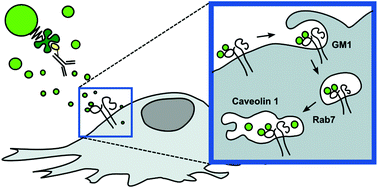Cellular recognition and macropinocytosis-like internalization of nanoparticles targeted to integrin α2β1†
Abstract
Targeting nanoparticles to desired intracellular compartments is a major challenge. Integrin-type adhesion receptors are connected to different endocytosis routes in a receptor-specific manner. According to our previous observations, the internalization of an α2β1-integrin-echovirus-1 complex takes place via a macropinocytosis-like mechanism, suggesting that the receptor could be used to target nanoparticles to this specific entry route. Here, silica-based nanoparticles, carrying monoclonal antibodies against the α2β1 integrin as address labels, were synthesized. Studies with flow cytometry, atomic force microscopy and confocal microscopy showed the particles to attach to the cell surface via the α2β1 integrin. Furthermore, quantitative analysis of nanoparticle trafficking inside the cell performed with the BioImageXD software indicated that the particles enter cells via a macropinocytosis-like process and end up in caveolin-1 positive structures. Thus, we suggest that different integrins can guide particles to distinct endocytosis routes and, subsequently, also to specific intracellular compartments. In addition, we show that with the BioImageXD software it is possible to conduct sensitive and complex analyses of the behavior of small fluorescent particles inside cells, using basic confocal microscopy images.


 Please wait while we load your content...
Please wait while we load your content...